USDOT Thriving Communities Program: East Orange & Orange, NJ
15 minutes Date Launched/Enacted: May 12, 2025 Date Published: May 13, 2025
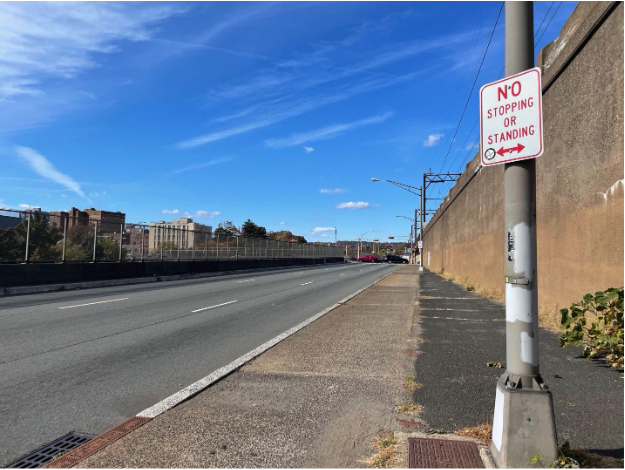
About the Thriving Communities Program (TCP)
The Thriving Communities Program (TCP) funds tailored technical assistance to under-resourced and disadvantaged communities, helping them better access historic infrastructure investments and deliver transformative projects. The USDOT FY 2022 Thriving Communities Program supports 64 communities across the country with access to a team of capacity builders to develop innovative community engagement methods, identify funding opportunities, and grow long-term capacity to develop and deliver transportation projects that strengthen communities.
TCP Complete Neighborhoods Community of Practice
TCP Communities are grouped into three Communities of Practice: Main Streets, Networked Communities, and Complete Neighborhoods. The 15 communities included under the Complete Neighborhoods Community of Practice are:
| Atlantic Beach, SC | Isabela, PR | Santa Cruz, CA |
| Billings, MT | Lansing, MI | St. Louis County, MO |
| Decatur, IL | Lima, OH | Suffolk, NY |
| East Orange, NJ | Providence, RI | Sumter, SC |
| Indianapolis, IN | Roanoke, VA | Waukegan, IL |
The US Department of Transportation (USDOT) selected a capacity building team led by RMI, including: the American Council for Energy-Efficient Economy (ACEEE), Equitable Cities, Nelson\Nygaard, and the Shared-Use Mobility Center (SUMC), to provide technical assistance to these 15 communities.

A Snapshot of Orange and East Orange, New Jersey
Orange and East Orange, New Jersey, share a deep historical and cultural connection dating to their early days as part of the City of Newark before becoming independent municipalities in the 19th century. Both cities thrived as vibrant suburban communities in the early 20th century, attracting white-collar professionals and business owners with their tree-lined streets, striking homes, and close proximity to Newark and New York City. However, like many inner-ring suburbs, they faced economic and demographic shifts in the mid-20th century due to continued suburbanization, industrial decline, and disinvestment, leading to challenges in housing, transportation, and economic opportunity.
Today, East Orange is a predominantly African American city with a population of approximately 69,000 people, (ACS 1-year, 2023). About 85% of residents identify as Black, alongside growing Hispanic, White, and other minority communities. The city faces economic hardships, with 1 in 5 individuals and 1 in 4 children living in poverty, and more than 75% of households classified as low-to-moderate income by HUD. More than 33% of households do not own a vehicle, making public transit access essential. Despite some of the hardships, the community is working towards increasing the quality of life for residents through safety campaigns, diverse programming, and infrastructure improvement projects.
Orange, a smaller but equally historic city, has a population of approximately 34,000 people and shares similar challenges and opportunities with its neighboring city. The city is more racially diverse than its neighbor, with 59.2% of the population being African American, followed by roughly 30% of Hispanic and Latino residents, which include a mix of long-term residents and newer immigrant communities. Like East Orange, a significant portion of Orange’s population relies on public transit, with limited vehicle ownership and strong dependence on bus and rail connections. Economic struggles persist, with roughly 20% of the population living in poverty, according to the 2023 Census. Nevertheless, Orange has made strides in community-driven development, housing improvements, and small business growth.
Both communities boast a strategic location for transportation connections to New York City and elsewhere in New Jersey. This includes a New Jersey Transit commuter rail station in both Orange and East Orange, as well as multiple bus routes, and highway connections via I-280. Nevertheless, many residents still struggle with safe transit access, affordable housing, and economic mobility.
Much of East Orange and Orange’s highway infrastructure has served to physically divide the cities. I-280, a below-grade freeway, is abutted by at-grade service roads on either side, Freeway Drive East and Freeway Drive West, which feature high-speed traffic, poor pedestrian crossings, and high rates of crashes. Together, Freeway Drive and I-280 create barriers to connectivity and economic opportunity for pedestrians and people on bikes.
In 2017, the Oranges completed the Freeway Drive & Station Area Safety and Public Realm Study (“Freeway Drive Study”) with support from the U.S. Department of Transportation, North Jersey Transportation Planning Authority, Federal Transit Administration, and the Federal Highway Administration. The study proposed reconnecting the north and south segments of the communities, currently split by I-280 and Freeway Drive, through improvements to bridges, roadways, and other transportation infrastructure to improve safety and support economic development. However, the New Jersey Department of Transportation (NJDOT) said more work was needed to show community alignment before they would consider improvements to Freeway Drive, which is a state road. Nevertheless, NJDOT remains concerned about recent pedestrian fatalities on Freeway Drive, creating an opening for a new dialogue on safety measures and other improvements on the road.
Notwithstanding these challenges, East Orange remains a city with a strong sense of community pride and ongoing efforts toward revitalization. The City has chosen to collaborate with Orange, as they share Freeway Drive’s most dangerous section. In addition to working together on the Thriving Communities Program, East Orange and Orange also jointly applied for and received the Robert Wood Johnson Foundation’s Community Connectors grant, which aims to help small and mid-sized communities repair the damage of divisive infrastructure. With their shared history, strategic location, and commitment to progress, the cities continue working to create a safer and more livable future for residents by addressing the impacts of Freeway Drive and I-280.
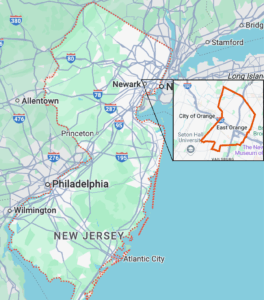
Location of East Orange and Orange in the state of New Jersey. Credit: SUMC
Key Initiatives for Transportation
The Capacity Building team, led by Equitable Cities, worked with the cities of Orange and East Orange to identify major goals to begin implementing community-prioritized short and medium-term initiatives mapped out in the 2017 Freeway Drive Study.
Community Engagement & Prioritization of Safety Plan
This initiative aims to update priorities from the 2017 Freeway Drive Study by gathering new community input through engagement sessions, public meetings, and data collection tools. By involving residents, the project ensures that planned improvements align with the most pressing safety concerns and community needs. The Capacity Building team led public engagement efforts to prioritize safety improvements from the 2017 Freeway Drive Study. The Capacity Building team developed a tailored public engagement process and created versatile data collection tools to effectively capture community input. Additionally, they held a bicycle safety event during the first site visit and worked with the cities to organize varied engagement activities to ensure residents have opportunities to voice their concerns and contribute to shaping safety improvements in their neighborhoods.
State and Regional Transportation Engagement
Because Freeway Drive is a state-owned road, New Jersey Department of Transportation (NJDOT) approval is essential for long-term improvements. This initiative focuses on identifying key stakeholders, building relationships, and aligning community priorities with regional transportation planning efforts to advance safety and infrastructure projects. To strengthen collaboration with transportation agencies, the Capacity Building team conducted a power mapping exercise to identify priority stakeholders. The team planned stakeholder engagement strategies and worked to build relationships with NJDOT and other agencies. Throughout the process, the Capacity Building team facilitated meetings to align community priorities with state transportation planning, ensuring that the concerns and needs of East Orange and Orange residents were considered in decision-making processes.
Demonstration Project Implementation
This project aims to demonstrate the potential of infrastructure improvements on city-owned roads, with the hope that it will influence similar installations on Freeway Drive. Through the joint efforts between the Robert Wood Johnson Foundation’s Community Connectors program and the Thriving Communities Program, the Capacity Building team will install temporary quick build demonstration projects at two intersections—one in Orange and one in East Orange—that have been identified as priority intersections for safety enhancements through community input and data analysis. The planned curb bump outs and crosswalks will be designed by a local artist and painted by residents to enhance the space and incorporate the local culture into the safety improvements.
Concurrent bike and pedestrian safety programming will bring volunteers to the event and highlight the safety enhancements of the quick build. As adding paint or temporary infrastructure improvements to Freeway Drive requires NJDOT approvals, which can be a long and bureaucratic process, the team facilitated implementation of independent projects on city-owned roads that abut Freeway Drive. These can serve as examples of the benefits of permanent improvements along Freeway Drive itself.
The purpose of the project is to illustrate to the community tangible improvements while building momentum for larger infrastructure changes. Additionally, it promotes placemaking efforts that make public spaces safer and more inviting. These quick-win projects improve community spaces and mobility, support placemaking initiatives, provide an opportunity for community programming, and reinforce the importance of engagement in public spaces.
Funding Identification and Support
In the same year that East Orange was awarded TCP funds, East Orange and Orange were also successful in winning the Robert Wood Johnson Foundation’s Community Connectors grant. The Capacity Building team supported the application for both of these programs, which facilitated braiding these two funding sources and coordinating the projects to augment the work of the quick build, street art, and safety programming. To ensure the sustainability of these initiatives, the Capacity Building team also helped identify funding opportunities for transportation safety and infrastructure projects. The team assisted in identifying federal, state, and philanthropic grants which could provide the communities with the financial resources needed to implement their plans. Furthermore, they supported the grant application process by developing funding strategies to maximize the likelihood of success.
Key Partners
Orange and East Orange are working with several key partners on these initiatives. Some of these partners include:
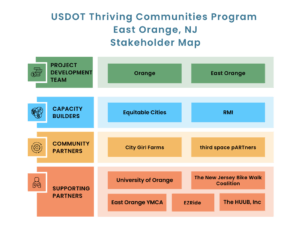
Stakeholder Map. Credit: SUMC.
Activities through the Thriving Communities Program
Building upon the key initiatives and recommended support efforts identified by Orange and East Orange leaders, the Capacity Building team focused efforts on four major activities: community engagement and data collection, placemaking, bike and pedestrian safety programming, and support pursuing funding opportunities.
Community Engagement and Data Collection
Though the 2017 Freeway Drive Study was robust in the community engagement, East Orange and Orange were interested in gathering additional data to supplement the study that was conducted prior to the pandemic. The Capacity Building team provided GIS mapping support to pinpoint businesses and transit stops along the study area. These maps and the stakeholder mapping matrix aided the development of an engagement plan. The cities chose to hire regional contractors to aid with the outreach and engagement around placemaking and bike and pedestrian safety. The subcontractors City Girl Farms and thirdspace pARTners were chosen as the leads for engagement around bike and pedestrian programming and art in the right-of-way, respectively.
The Capacity Building team worked with the community team to develop a survey to conduct at the first site visit and to host on the Freeway Drive for All website. The Capacity Building team also created a website to allow for asynchronous community engagement through the survey, an interactive map where people can leave comments, project information, and a calendar of upcoming events. The Capacity Building team created the survey in English, Spanish, and Haitian Creole, the most spoken languages of the area, and is continuing to gather data. Community input has informed the placemaking and programming locations, and will inform future funding applications.
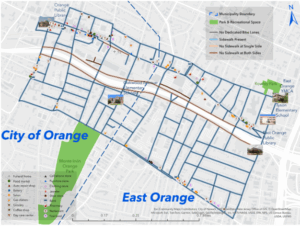
GIS Map of Amenities Near the Freeway Drive Corridor in Orange and East Orange. Credit: Equitable Cities.
New Jersey Department of Transportation (NJDOT) Engagement
Through the collaborative efforts of both grant programs, the Capacity Building team worked with the city to leverage connections with NJDOT to increase regional coordination on safety enhancements along Freeway Drive. In December 2024, the Capacity Building team and the city met with NJDOT’s Director of Safety Programs and Transportation Data to discuss the condition of Freeway Drive and the progress made through the Thriving Communities and Community Connectors programs. Although previous attempts to engage state transportation leaders have been met with limited success, persistent safety concerns and a demonstrated prioritization from the municipalities led NJDOT to ultimately commit to installing permanent safety infrastructure improvements on Freeway Drive. Building on this momentum, the Oranges are now working with the state DOT to advance corridor improvement efforts. A road safety audit, planned for later in 2025, will be led by NJDOT and supported by the city. It will convene a team of DOT subject matter experts, city representatives and other local stakeholders to walk the corridor and collaboratively develop recommendations for permanent improvement. Though the 2017 Freeway Drive Study remains a basis for priority needs, newly collected data from the TCP and insights from the upcoming road safety audit will help inform NJDOT of which improvements are most responsive to current conditions and community needs in a post-COVID context.
Placemaking
Lillian Cho of thirdspace pARTners focused on engaging local artists to develop street art for a pilot quick build near Freeway Drive. By coordinating with Street Plans, the leaders of the quick build through the Community Connectors grant, and leveraging the TCP efforts towards placemaking through art, Cho played a pivotal role in engaging stakeholders and residents to provide input on the quick build sites, inform the street art, and partake in the installation of the safety enhancements. She held public meetings, met with local stakeholders, such as the University of Orange and HUUB Inc, and worked with the cities to develop a steering committee for continued engagement around the implementation of street art to enhance transportation safety. The input from the events and website helped inform the themes that the artists used to develop their work. Once the city approved the schematic drawings, Cho worked to spread the word about the quick build installation event and register volunteers to help paint. The resident-led application of art in both Orange and East Orange aims to bring communities together and foster collaboration across the cities.
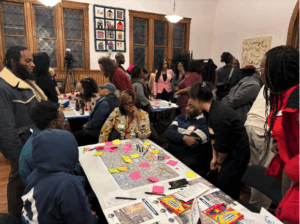
Community partner engagement with stakeholders in Orange and East Orange. Credit: Equitable Cities.
Bike and Pedestrian Safety Programming
Abeni Ramsey, from City Girl Farms, focused on outreach for the bike and pedestrian programming along Freeway Drive. She worked with EZRide and the New Jersey Bike & Walk Coalition to develop programs at the East Orange Public Library, East Orange YMCA, and at the street art implementations at the quick builds in both Orange and East Orange. The East Orange Public Library hosted an event led by EZRide, with a bike obstacle course and bike safety training. Families passing through the library stopped by the event tent to test out their biking skills and learn about the Freeway Drive Study.
The event at the YMCA aimed to engage the youth, which was identified as a priority in the Freeway Drive Study. EZRide worked with Abeni Ramsey to determine indoor activities for the kids with bikes, and to gather information on how families feel biking around the Freeway Drive corridor. The event also served as a tabling opportunity to share project information and connect parents to the website to gather additional community input about Freeway Drive.
Finally, the bike and pedestrian programming at the quick build unveiling will bring some attendees to the street art implementation on bike, through a bike ride organized by Friends of Metcalf Park and City Girl Farms. The bike ride is intended to show residents how safety along Freeway Drive would be improved by the installation of the quick build and accompanying street art. EZRide is working with Ramsey to develop a bike safety workshop near the quick build to teach participants about safe biking behaviors.
Identifying Funding Opportunities
The Capacity Building team led the task of identifying funding opportunities tailored to the specific needs of Orange and East Orange, New Jersey, to support transportation safety, infrastructure improvements, and community development. Their process entailed a thorough assessment of available municipal, state, federal, and philanthropic funding sources, ensuring alignment with the community’s priorities. The purpose of this initiative was to secure the necessary funding to implement both short-term and long-term projects, ensuring that critical safety improvements, public space enhancements, and mobility solutions could move forward. By leveraging these financial opportunities, the Capacity Building team helped empower the communities of Orange and East Orange to create a safer, more connected, and more livable urban environment.
Conclusion
The USDOT Thriving Communities Program has provided the cities of Orange and East Orange with an opportunity to advance their key goals: implementing community-prioritized safety improvements, fostering strong relationships with local transportation agencies, and creating safer, more connected, and more livable communities. The Capacity Building team collaborated closely with community leaders to pinpoint the most effective strategies for supporting these goals and driving meaningful progress. Over the course of this program, the Capacity Building team has provided support to foster stronger relationships with NJDOT, and improvements in infrastructure and mobility highlighted in the 2017 Freeway Drive Study. This program has empowered local leaders to create sustainable, inclusive, beautiful, and accessible transportation solutions, ultimately enhancing the quality of life for residents.
Key Partners
- City Girl Farms – A regional food justice organization that represented the TCP team during local engagement activities. They coordinated events and community programs to support the initiative.
- thirdspace pARTners – A consulting organization working at the intersection of public art, placemaking, and urban planning. They played a role in community engagement, outreach, and working with local artists to design street mural art for the quick-build demonstration.
- East Orange YMCA – A nonprofit organization committed to strengthening communities. They supported community engagement activities by assisting with outreach, hosting events, and providing programming to encourage resident participation.
- EZRide – A Newark-based community transportation services organization that works regionally to help residents meet their transportation needs. Their bike and pedestrian programs work to help local leaders improve safety and promote walking and bicycling.
- The New Jersey Bike Walk Coalition – The coalition aims to build a movement that strives for easy biking and walking within and between cities for a more accessible, sustainable, and equitable state.
- University of Orange – The university is a free school focused on restoration urbanism, collective organizing, and capacity building for resident empowerment and policy change.
- The HUUB, Inc – This Unitarian Universalist Church urban ministry is an anchor institution in Orange that serves as a welcoming resource for residents to gather and organize for social justice.
- Friends of Metcalf Park – This Orange-based organization works towards equitable and accessible open spaces for all, with an emphasis on environmental justice and active living.
Related Resources
Capacity building efforts through the Thriving Communities Program are continuing through May 2025. The Capacity Building team will conduct more technical assistance activities and will update this case study as the program progresses.